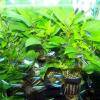Hygrophila salicifolia
Scientific name: Hygrophila salicifolia
Family: Acanthaceae
Maximum size reached under cultivation: 25 - 70 cm (9.84 - 27.56 inch)
014
Recommended pH range: 6.2 - 7.3
Recommended water hardness: 4 - 12°dGH (71.43 - 214.29ppm)
0°C 32°F30°C 86°F
Recommended temperature range: 22 - 25 °C (71.6 - 77°F)
Preferred propagation method: Cuttings
Native to: South Asia
Growth rate: Fast
Recommended substrate: Fine gravel
Lighting requirements: Bright
Ideal placement in tank: Background
Common Name
Willow Leaf Hygro
Scientific Name
Hygrophila salicifolia (often sold as Hygrophila stricta)
Origin
Hygrophila salicifolia originates from South and Southeast Asia, where it grows in slow-moving rivers, wetlands, and seasonally flooded fields. In nature, it often grows emersed during dry seasons and submerged during periods of higher water levels. Its adaptability has led to its popularity in the aquarium trade, especially under the name Hygrophila stricta.
Growing Conditions
This plant can thrive in both submerged and emersed conditions. When grown emersed, it develops slightly thicker leaves and can produce purple flowers. Underwater, its long, narrow leaves create a lush, willow-like appearance.
Hygrophila salicifolia prefers bright lighting to support rapid growth and vibrant leaf coloration, which can range from green to reddish hues depending on light intensity. It does best in a nutrient-rich environment with a pH between 6.2 and 7.3 and water hardness of 4 – 12 dGH. Ideal temperatures range from 22 – 25 °C (71.6 – 77 °F).
Although it grows quickly without it, CO2 supplementation and fertilization will further enhance its development and coloration.
Planting Area
Due to its height (up to 70 cm / 27.56 inches), this plant is best suited to the background of larger aquariums. It adds vertical structure and provides shelter for shy fish or fry. In open-top tanks, the stems may rise above the surface and flower, though this often leads to leaf loss near the base.
Propagation
Hygrophila salicifolia propagates easily through cuttings. To propagate, take a stem cutting from a healthy plant, remove the lower leaves, and plant it in fine gravel substrate. The cutting will develop roots and grow into a new plant within a short period. While propagation from seeds is possible if the plant flowers, this method is unreliable and rarely used in aquariums.
Difficulty
This is an easy-to-grow plant, suitable even for beginners. It requires minimal maintenance but benefits greatly from regular trimming to encourage bushier growth and to prevent the lower parts from shedding leaves in low light or emersed conditions.
Short Description
Hygrophila salicifolia, often referred to as Willow Leaf Hygro or sold as Hygrophila stricta, is a fast-growing, undemanding stem plant ideal for background placement in medium to large aquariums. It is known for its slender, willow-like leaves and its ability to absorb excess nutrients such as nitrates, helping to reduce algae growth.
With sufficient light, its leaves may develop a reddish tint. While tolerant of lower lighting conditions, growth will slow and the plant may lose foliage near the base. In open aquariums, it may emerge above the water and bloom, producing attractive purple flowers. However, to maintain dense underwater foliage, trimming before emergence is recommended.
Due to its rapid growth, Hygrophila salicifolia can become invasive in some regions. Proper disposal of trimmings is necessary to prevent unwanted spread into natural ecosystems.

 Hygrophila corymbosa
Hygrophila corymbosa Hygrophila difformis
Hygrophila difformis Hygrophila difformis variegated
Hygrophila difformis variegated Hygrophila guianensis
Hygrophila guianensis Hygrophila polysperma
Hygrophila polysperma Hygrophila polysperma ‘Rosanervig’
Hygrophila polysperma ‘Rosanervig’ Synnema triflorum
Synnema triflorum